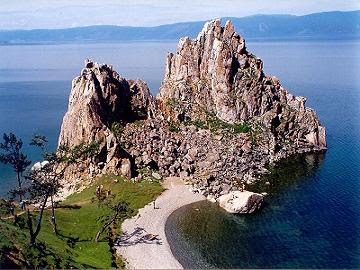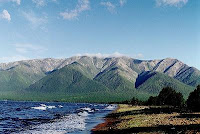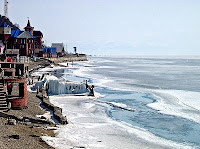Lake Baikal is the worlds second most voluminous lake, after the Caspian Sea. It is the most voluminous freshwater lake in the world with an average depth of 744.4 m or 2,442 ft and contains a total of roughly 20 percent of the world's surface fresh water. Lake Baikal is one of the famous tourist attraction and travel destination. The important aspect of Lake Baikal is explained in world tour guides in detail below. Located in the south of the Russian region of Siberia between Irkutsk Oblast to the northwest and the Buryat Republic to the southeast, near the city of Irkutsk, the body of water is also known as the Pearl of Siberia.
 Lake Baikal is the deepest and among the clearest of all lakes in the world. At more than 25 million years old, Baikal is also the world's oldest lake. Like Lake Tanganyika, Lake Baikal was formed as an ancient rift valley, having the typical long crescent shape with a surface area of 31,722 km2 or 12,248 sq mi, less than that of Lake Superior or Lake Victoria. Baikal is home to more than 1,700 species of plants and animals, two thirds of which can be found nowhere else in the world and was declared a UNESCO World Heritage Site in 1996. It is also home to Buryat tribes who reside on the eastern side of Lake Baikal, rearing goats, camels, cattle and sheep, where the regional temperature varies from a minimum of -19°C or -2.2°F in winter to maximum of 14°C or 57.2°F in summer.
Lake Baikal is the deepest and among the clearest of all lakes in the world. At more than 25 million years old, Baikal is also the world's oldest lake. Like Lake Tanganyika, Lake Baikal was formed as an ancient rift valley, having the typical long crescent shape with a surface area of 31,722 km2 or 12,248 sq mi, less than that of Lake Superior or Lake Victoria. Baikal is home to more than 1,700 species of plants and animals, two thirds of which can be found nowhere else in the world and was declared a UNESCO World Heritage Site in 1996. It is also home to Buryat tribes who reside on the eastern side of Lake Baikal, rearing goats, camels, cattle and sheep, where the regional temperature varies from a minimum of -19°C or -2.2°F in winter to maximum of 14°C or 57.2°F in summer.Lake Baikal was known as the "North Sea" in historical Chinese texts. It was situated in the then Xiongnu territory. Very little was known to Europeans about the lake until the Russian expansion into the area in the 17th century. The first Russian explorer to reach Lake Baikal was Kurbat Ivanov in 1643. The Trans-Siberian railway was built between 1896 and 1902. The scenic railway around the southwestern end of Lake Baikal required 200 bridges and 33 tunnels; until its completion, a train ferry transported railcars across the lake for a number of years.
Lake Baikal is in a rift valley, created by the Baikal Rift Zone, where the crust of the earth is pulling apart. At 636 kilometres long and 79 kilometres wide, Lake Baikal has the largest surface area of any freshwater lake in Asia and is the deepest lake in the world. The bottom of the lake is 1,186.5 metres below sea level, but below this lies some 7 kilometres or 4.3 mi of sediment, placing the rift floor some 8–11 kilometres more than 5 miles below the surface. The deepest continental rift on Earth. In geological terms, the rift is young and active it widens about two cm per year. The fault zone is also seismically active; there are hot springs in the area and notable earthquakes every few years. The lake drains into the Angara tributary of the Yenisei.
Its age is estimated at 25–30 million years, making it one of the most ancient lakes in geological history. It is unique among large, high-latitude lakes, in that its sediments have not been scoured by overriding continental ice sheets. U.S. and Russian studies of core sediment in the 1990s provide a detailed record of climatic variation over the past 250,000 years. Longer and deeper sediment cores are expected in the near future. Lake Baikal is furthermore the only confined fresh water lake in which direct and indirect evidence of gas hydrates exists.
The lake is completely surrounded by mountains. The Baikal Mountains on the north shore and the taiga are technically protected as a national park. It contains 27 islands; the largest, Olkhon, is 72 kilometres long and is the fourth-largest lake-bound island in the world. The lake is fed by as many as three hundred and thirty inflowing rivers. The main ones draining directly into Baikal are the Selenga River, the Barguzin River, the Upper Angara River, the Turka River, the Sarma River and the Snezhnaya River. It is drained through a single outlet, the Angara River.

 Lake Baikal hosts 1,085 species of plants and 1,550 species and varieties of animals. Epischura baikalensis is endemic to Lake Baikal and the dominating zooplankton species there, making up 80 to 90 percent of total biomass. The Baikal Seal or nerpa is found throughout Lake Baikal. The two important species of Lake Baikal are golomyanka or Baikal oil fish. These long finned, translucent fish normally live in depths of 200 to 500 metres and are primary prey of Baikal seal. The Baikal grayling, a fast swimming salmonid, popular among anglers and the Baikal sturgeon, are both important endemic species with commercial value
Lake Baikal hosts 1,085 species of plants and 1,550 species and varieties of animals. Epischura baikalensis is endemic to Lake Baikal and the dominating zooplankton species there, making up 80 to 90 percent of total biomass. The Baikal Seal or nerpa is found throughout Lake Baikal. The two important species of Lake Baikal are golomyanka or Baikal oil fish. These long finned, translucent fish normally live in depths of 200 to 500 metres and are primary prey of Baikal seal. The Baikal grayling, a fast swimming salmonid, popular among anglers and the Baikal sturgeon, are both important endemic species with commercial valueThe lake called the Pearl of Siberia drew investors from the tourist industry as energy revenues sparked an economic boom. Viktor Grigorov's Grand Baikal in Irkutsk is one of the investors, who planned to build three hotels creating 570 jobs. In 2007, the Russian government declared the Baikal region a special economic zone. The popular resort of Listvyanka is home to the seven-story Hotel Mayak. Baikal was also declared a UNESCO World Heritage site in 1996.
Post Title
→Lake Baikal
Post URL
→https://guidice-galleries.blogspot.com/2010/05/lake-baikal.html
Visit guidice galleries for Daily Updated Wedding Dresses Collection








